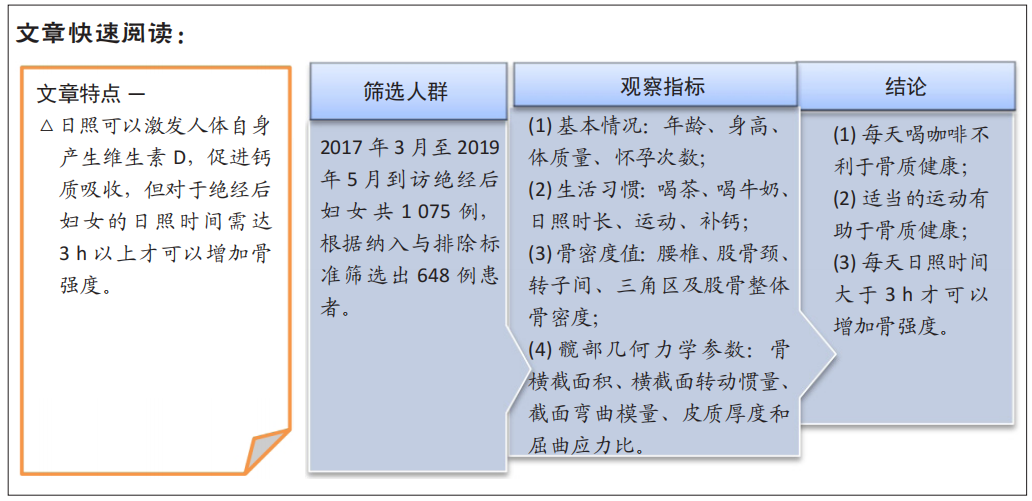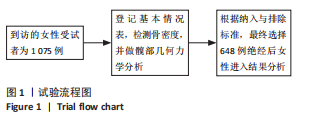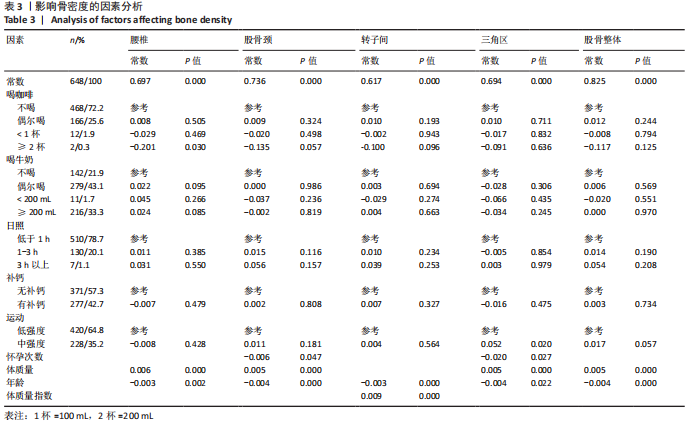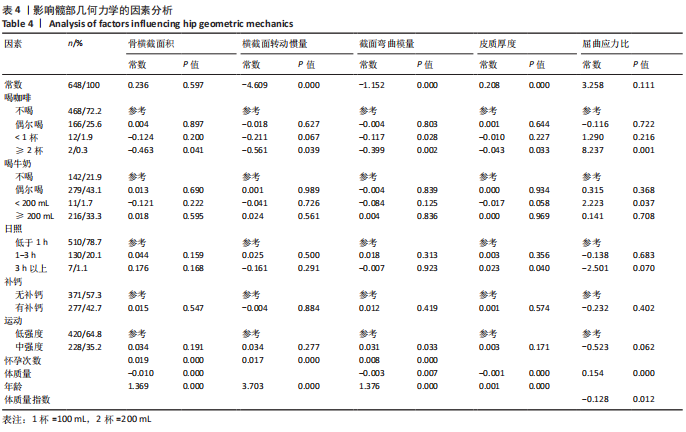中国组织工程研究 ›› 2021, Vol. 25 ›› Issue (27): 4277-4282.doi: 10.12307/2021.182
• 骨与关节生物力学 bone and joint biomechanics • 上一篇 下一篇
绝经后妇女髋部几何力学参数与生活习惯的相关性
叶云金,葛继荣,陈 娟,李健阳,柴 昊,谢丽华
- 1福建省中医药科学院,福建省福州市 350003;2福建中医药大学,福建省福州市 350122
Correlation between hip geometric mechanics and lifestyle habits in postmenopausal women
Ye Yunjin, Ge Jirong, Chen Juan, Li Jianyang, Chai Hao, Xie Lihua
- 1Fujian Academy of Chinese Medical Sciences, Fuzhou 350003, Fujian Province, China; 2Fujian University of Traditional Chinese Medicine, Fuzhou 350122, Fujian Province, China
摘要:

文题释义:
髋关节结构分析软件:美国The Johns Hopkins University大学THOMAS BECK教授多年来应用CT和双能X射线骨密度仪通过骨几何学特征及一些骨结构指标来研究髋关节近端骨强度,建立了相应的髋关节结构分析系统几何学模型,其作用主要用于了解骨几何力学特征,是用于科研和药物治疗研究最领先的骨结构分析手段。美国 The Johns Hopkins University 大学拥有其专利及商业注册,2006年2月美国 Hologic公司与其签署协议在双能 X 射线数字化骨密度仪中独家使用髋关节结构分析软件,透过骨密度扫描的髋部近端骨成像分析其几何力学的参数。
骨质疏松症:是一种因骨量低下、骨结构损坏导致骨脆性增加、发生骨折的全身性骨病。
背景:在骨质疏松症研究中已有众多文献对于骨密度进行报道,但仍未能充分说明骨强度以及骨折的问题,此文基于髋部力学来研究骨强度,希望对现有的研究有所补充。
目的:了解绝经后妇女的生活习惯对髋部几何力学的影响。
方法:选取648例绝经后妇女,均使用双能X射线数字化骨密度仪扫描腰椎(L1-L4)及左髋关节(全髋、股骨近端),并得出相应的骨密度值及髋部几何力学5个参数:骨横截面积、横截面转动惯量、截面弯曲模量、皮质厚度和屈曲应力比。采用线性分析法分析生活习惯与骨密度值及髋部几何力学的相关性。
结果与结论:①影响骨密度的因素分析:年龄、每天喝2杯以上咖啡及怀孕次数与骨密度呈负相关(P < 0.05);体质量、体质量指数及中强度的运动与骨密度呈正相关(P < 0.05);②影响髋部几何力学的因素分析:年龄、每天喝咖啡与骨横截面积、横截面转动惯量、截面弯曲模量、皮质厚度呈负相关(P < 0.05),年龄、每天喝咖啡及每天少于1杯牛奶与屈曲应力比呈正相关(P < 0.05);体质量、身高、日照时间大于3 h及中强度运动与骨横截面积、横截面转动惯量、截面弯曲模量、皮质厚度呈正相关(P < 0.05);体质量指数与屈曲应力比呈负相关(P < 0.05);③提示每天喝咖啡不利于骨质健康,适当的运动有助于骨质健康,日照时间大于3 h才可以增加骨强度。
https://orcid.org/0000-0003-2135-2657 (叶云金)
中国组织工程研究杂志出版内容重点:人工关节;骨植入物;脊柱;骨折;内固定;数字化骨科;组织工程
中图分类号:




